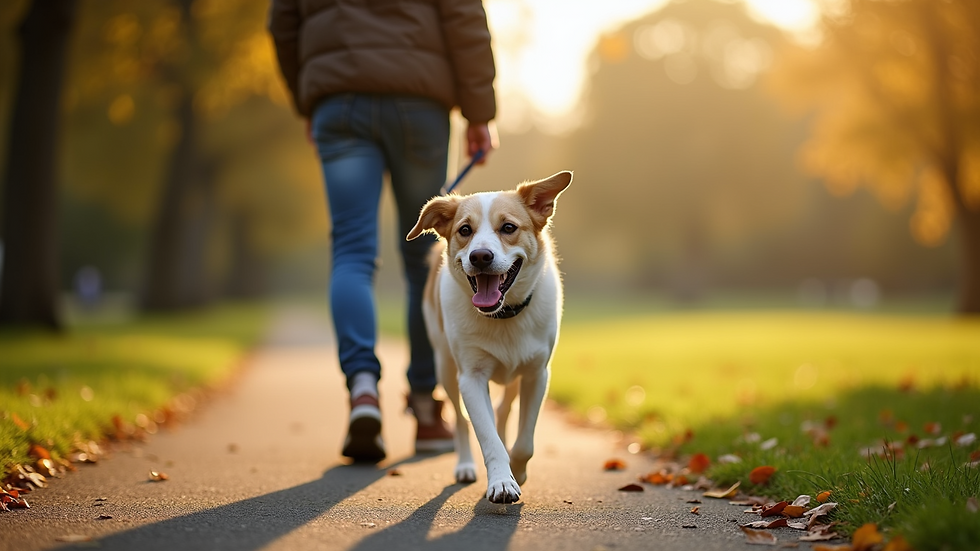Transforming Anxiety into Joy How Daily Walks Can Cure Your Dog's Separation Woes
- Dereck Pazmino
- May 26
- 3 min read
Dogs might be dubbed man's best friend, but even these furry pals have their own set of worries that can mess with their tail-wagging happiness. Take separation anxiety, for example—it's like a canine soap opera whenever their humans step out the door. This emotional drama can lead to Oscar-worthy performances involving chewed-up furniture and nonstop barking. But fear not! The plot twist here is that a good old routine of daily walks can magically transform their anxiety into pure, unbridled joy. It's like turning a telenovela into a feel-good comedy!
Understanding Separation Anxiety in Dogs
Separation anxiety is an emotional issue that impacts dogs of all breeds and ages. It occurs when a dog becomes overly attached to its owner, leading to distress when left alone. Some common signs include:
Barking or howling: Some dogs may vocalize excessively when they feel abandoned.
Destructive behavior: Chewing on furniture or digging can occur as a way to cope with stress.
Attempts to escape: Dogs may try to run away when their owners leave, putting them in danger.
Recognizing these signs and understanding the roots of separation anxiety helps in creating a supportive environment for your furry friend.
The Benefits of Daily Walks
Physical Exercise
Daily walks provide essential physical exercise that dogs need. A simple 30-minute walk can greatly improve your dog's overall fitness. Not only does regular activity help regulate weight, but it also serves to release excess energy. For example, studies show that dogs who get at least two hours of exercise each day are less likely to show signs of behavioral issues.
Mental Stimulation
Walks also offer valuable mental stimulation. The outdoors is full of fresh sights, sounds, and scents that capture your dog’s interest. A study found that dogs exposed to new environments during their walks are less anxious and more engaged in their surroundings. This mental engagement distracts them from feelings of anxiety, allowing them to explore and enjoy their environment.
Creating Positive Associations
Daily walks can foster positive connections with the owner's absence. If a dog associates their owner's departure with an enjoyable experience like a walk, it lessens their anxiety. Gradually, the excitement of the walk can counterbalance feelings of stress when left alone, making separations easier for them.
Establishing a Routine
Consistency is Key
To effectively support a dog with separation anxiety, consistent walking routines are vital. Dogs thrive on predictability. Aim to take your dog on walks at the same times each day. For instance, scheduling walks in the morning and evening not only sets a steady routine but also creates something for your dog to anticipate, reducing overall anxiety levels.
Varying the Routes
While sticking to a routine is important, try varying your walking routes as well. Exploring new neighborhoods or parks introduces fresh stimuli, capturing your dog’s curiosity. Walking in different areas can help keep the experiences exciting and mentally enriching, further staving off anxiety.
Socialization Opportunities
Positive Interactions
Daily walks can also provide socialization opportunities. Encountering other dogs or friendly people can help your dog feel more secure. For instance, a study suggests that dogs regularly exposed to different environments and individuals see a 30% reduction in fear-based behaviors. These experiences can make your dog more adaptable to changes, including your absences.
Controlled Exposure
Socializing during walks allows for supervision over interactions. If your dog shows signs of anxiety around other dogs, you can manage situations to ensure they feel safe. Gradual exposure, along with positive interactions, can lead to more confident and emotionally stable dogs.
Building a Stronger Bond
Quality Time Together
Daily walks are beneficial for both dogs and their owners. Spending uninterrupted time together strengthens the bond and builds trust. A strong attachment can help soothe your dog's anxiety, making them feel more loved and secure.
Training Sessions on the Go
Consider integrating training exercises during your walks. Teaching commands or tricks adds mental stimulation while reinforcing your bond. For instance, rewarding your dog for following commands during walks increases their confidence and reduces stress.
Embracing Everyday Adventures
Separation anxiety can be a tough issue, but regular daily walks can make a remarkable difference. These walks provide physical exercise, mental stimulation, and socialization opportunities that contribute to your dog's overall well-being. By establishing a consistent walking routine, you not only change anxiety into joy but also deepen the bond between you and your dog.
With patience and commitment, your canine friend can learn to embrace moments of separation more calmly. So grab that leash, take your furry companion out for a stroll, and experience the incredible transformation that daily walks can bring.




Comments